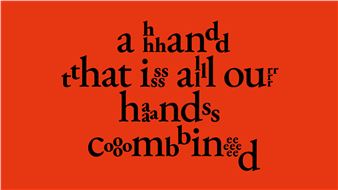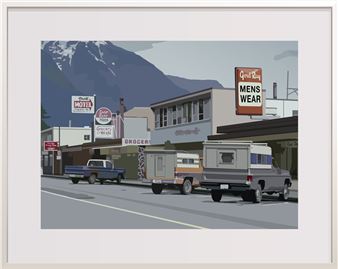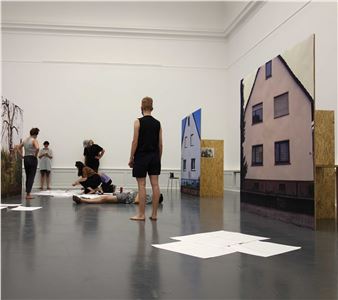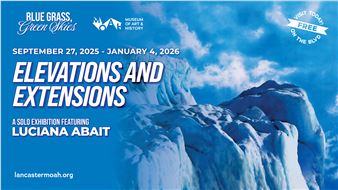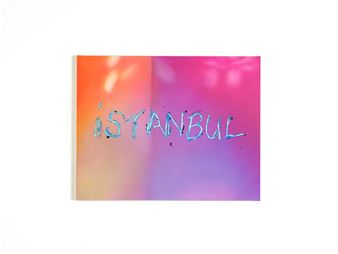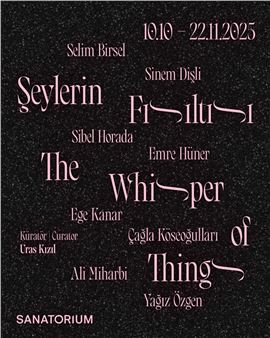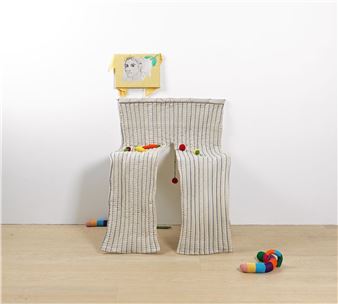Hamra Abbas: But can you show this in Pakistan?
PД°LOT is hosting Hamra AbbasвҖҷ new solo exhibition вҖңBut can you show this in Pakistan?вҖқ between November 5 and December 12, 2015. The third solo exhibition of the artist in Istanbul features two latest series that consists of drawings and miniatures.
In Urdu and a few regional languages spoken in Pakistan (and some parts of India) single word is used both for fornicating and killing. Perhaps a parallel can be drawn between this linguistic limit and several erotic Indian miniature paintings in which a ruler is making love to a woman (often in an unimaginable position) and simultaneously pointing his arrow, lance or sword towards an animal. Uniformity of two expressions вҖ“ from visual and vocal domains вҖ“ may be understood in the fact that both in the mating and in killing with a weapon, a linear foreign entity enters the body of its subject/target/prey.
Today not only in the act of lovemaking but in other activities which include inhalation (both the actual and virtual), a certain kind of pleasure is sought. Satisfaction a man and woman (but primarily man вҖ“ in patriarchal societies!) attain in a private space now can be matched with fascination a group of militants aspires to while imposing their doctrine/version of a faith and slaughtering humans who resist or belong to other sects or sets of beliefs. Public display of orgy like mass murders is a sign of what type of thrill the acts of brutalities can provide.
In present age, with media (like the conventional concept of God) being everywhere and attentive all the times, both the sex and violence have become materials for marketing purposes. So today a voyeur is not the one who gazes and lusts after pictures of porn in his room, but a person who sits in front of news channels and watches continuous reportage of bomb explosions, fire sights, public shootings or accidents on huge scale. Like the perpetual viewing of naked bodies ends up making a person oblivious to the charm of nudity, similarly perpetual broadcasting of images of violence turns a spectator indifferent from the reality of that incident. As the repeated telecast of tragedy will become a farce (if someone is still inclined or interesting in watching it again!).
Hamra Abbas alludes to that connection of violence and the attraction of violence that stems from traditional Indian miniature painting, but have the potential of becoming the metaphor of our times. Times, which are marred (or adorned) with the cruelty of death and destruction. The most horrible phase in the recent history of terrorism is undoubtedly the attacks on Word Trade Centre, but after fifteen years to that event, now the 9/11 has been reduced to вҖҳarchetypicalвҖҷ or beautiful image of smoke coming out of two towers. Likewise other examples of violence are destined to be enjoyed as picturesque visuals, or admired as great pieces of literature. In AbbasвҖҷs recent works (which are in continuity of her Lessons of love sculpture series) sensuousness and savagery intermingle. She relies on the diction of conventional aesthetics of Indian miniature painting, yet the introduction of background colours, and simplification of composition suggest the presence of present day sensitivity in image making.
AbbasвҖҷs portraits in digital medium are not much different from her immaculately rendered works on smaller scale, because in these too, the artist indicates an act of transformation of a real person to an art objects, through a playfulness of putting moulding clay to formulate facial features. After Marcel Duchamp the world вҖ“ or the art world realized that it is the artist who is more important than the artwork, hence his personality dominates his production. In the set of portraits of artists (including Beuys, Bourgeois, Abramovic and Close) one comes to know the power of art makers in comparison to what is created. Their portraits, like the statues of modern day deities, command a respect, adoration and admiration that can be equated with the ancient idols.
The power of making art, in comparison to other pursuits of power is visible in AbbasвҖҷs series of life size drawings of human beings. These people вҖ“ varying in terms of gender, age, ethnicity and sexual preference stand in front of the artist, stark nude and offering their bodies like classical sculptures; if on the one hand can be comprehended as exercises in rendering human anatomy, at the same instance can be read being a comment upon transforming a living being into an art object. Their presence in a studio standing in a confronting posture is significant, because their bodies, without any context or association determine how a person encounters another body and realizes that humans can be separate in terms of their origin, yet they may pose a problem as they present a basic existential dilemma of dealing with the Other. The fact of these being life size drawings, facing the audience in a simple manner, in one way documents the ritual of academic studies of art, but it also includes the problem of possessing a self in contemporary world, no matter if that other is from oneвҖҷs heritage, training, surroundings or imagination.
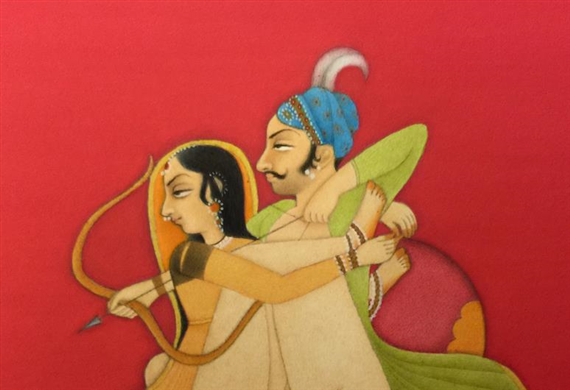
Recommended for you
PД°LOT is hosting Hamra AbbasвҖҷ new solo exhibition вҖңBut can you show this in Pakistan?вҖқ between November 5 and December 12, 2015. The third solo exhibition of the artist in Istanbul features two latest series that consists of drawings and miniatures.
In Urdu and a few regional languages spoken in Pakistan (and some parts of India) single word is used both for fornicating and killing. Perhaps a parallel can be drawn between this linguistic limit and several erotic Indian miniature paintings in which a ruler is making love to a woman (often in an unimaginable position) and simultaneously pointing his arrow, lance or sword towards an animal. Uniformity of two expressions вҖ“ from visual and vocal domains вҖ“ may be understood in the fact that both in the mating and in killing with a weapon, a linear foreign entity enters the body of its subject/target/prey.
Today not only in the act of lovemaking but in other activities which include inhalation (both the actual and virtual), a certain kind of pleasure is sought. Satisfaction a man and woman (but primarily man вҖ“ in patriarchal societies!) attain in a private space now can be matched with fascination a group of militants aspires to while imposing their doctrine/version of a faith and slaughtering humans who resist or belong to other sects or sets of beliefs. Public display of orgy like mass murders is a sign of what type of thrill the acts of brutalities can provide.
In present age, with media (like the conventional concept of God) being everywhere and attentive all the times, both the sex and violence have become materials for marketing purposes. So today a voyeur is not the one who gazes and lusts after pictures of porn in his room, but a person who sits in front of news channels and watches continuous reportage of bomb explosions, fire sights, public shootings or accidents on huge scale. Like the perpetual viewing of naked bodies ends up making a person oblivious to the charm of nudity, similarly perpetual broadcasting of images of violence turns a spectator indifferent from the reality of that incident. As the repeated telecast of tragedy will become a farce (if someone is still inclined or interesting in watching it again!).
Hamra Abbas alludes to that connection of violence and the attraction of violence that stems from traditional Indian miniature painting, but have the potential of becoming the metaphor of our times. Times, which are marred (or adorned) with the cruelty of death and destruction. The most horrible phase in the recent history of terrorism is undoubtedly the attacks on Word Trade Centre, but after fifteen years to that event, now the 9/11 has been reduced to вҖҳarchetypicalвҖҷ or beautiful image of smoke coming out of two towers. Likewise other examples of violence are destined to be enjoyed as picturesque visuals, or admired as great pieces of literature. In AbbasвҖҷs recent works (which are in continuity of her Lessons of love sculpture series) sensuousness and savagery intermingle. She relies on the diction of conventional aesthetics of Indian miniature painting, yet the introduction of background colours, and simplification of composition suggest the presence of present day sensitivity in image making.
AbbasвҖҷs portraits in digital medium are not much different from her immaculately rendered works on smaller scale, because in these too, the artist indicates an act of transformation of a real person to an art objects, through a playfulness of putting moulding clay to formulate facial features. After Marcel Duchamp the world вҖ“ or the art world realized that it is the artist who is more important than the artwork, hence his personality dominates his production. In the set of portraits of artists (including Beuys, Bourgeois, Abramovic and Close) one comes to know the power of art makers in comparison to what is created. Their portraits, like the statues of modern day deities, command a respect, adoration and admiration that can be equated with the ancient idols.
The power of making art, in comparison to other pursuits of power is visible in AbbasвҖҷs series of life size drawings of human beings. These people вҖ“ varying in terms of gender, age, ethnicity and sexual preference stand in front of the artist, stark nude and offering their bodies like classical sculptures; if on the one hand can be comprehended as exercises in rendering human anatomy, at the same instance can be read being a comment upon transforming a living being into an art object. Their presence in a studio standing in a confronting posture is significant, because their bodies, without any context or association determine how a person encounters another body and realizes that humans can be separate in terms of their origin, yet they may pose a problem as they present a basic existential dilemma of dealing with the Other. The fact of these being life size drawings, facing the audience in a simple manner, in one way documents the ritual of academic studies of art, but it also includes the problem of possessing a self in contemporary world, no matter if that other is from oneвҖҷs heritage, training, surroundings or imagination.
Artists on show
Contact details


 ARTISTS
ARTISTS







